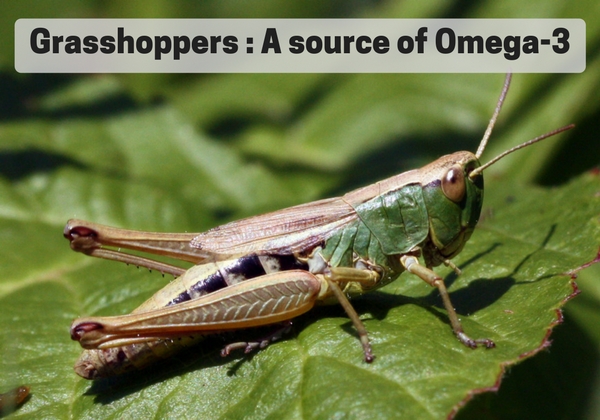Edible Grasshoppers : an excellent source of Omega-3
Edible insects are becoming more and more popular. As the topic is getting more discussed, we start identifying the species. Now in US, crickets are the most popular whereas, in Europe, mealworms seem to have the favor. But what about the edible grasshoppers, the crickets big cousins? Even if they are farmed and available in Europe, they don’t have much attention. Nevertheless, grasshoppers are delicious, really nutritious with an especially high content in Omega 3. Omega 3 fatty acid are goods for the brain, it will be easier to focus on grasshoppers!
The meadow grasshoppers as an example
The desert locusts (Schistocerca gregaria) and the migratory locusts (Locusta migratoria) are the grasshoppers species bred in Europe. For more information, I wrote an article about the differences between grasshoppers, locusts, crickets and katydids.
While those species are not native from Europe, Aman Paul studied the breeding potential and nutritional composition of a European grasshopper; the Chorthippus parallelus or meadow grasshopper.
You surely saw them during the summer but did you know that they were so nutritious?

Edible grasshoppers : Rich in proteins and a surprising high content in Omega-3
According to the study, edible grasshoppers contain a really high protein content on dry matter. They contain 69% of proteins compared to 40 and 55% for beef and chicken. The protein source is better absorbed than soybeans. Moreover, this is a complete source of proteins; meaning that all essential amino acids are present in a sufficient amount.
While we know that edible insects are high in proteins and minerals, we talk less about the fatty acids.
Nevertheless, fatty acids are really important and some of them are even essential for our body. This is the case of the omega-3 or linolenic acid. They have anti-inflammatory properties, lower blood cholesterol and are involved in brain development.
This high content in Omega-3 is really interesting for a notable reason. Our modern diet lacks this key nutrient.
The ratio Omega 6:3 as a key element
In fact, the problem of our modern diet regarding omega-3 lies in the ratio between omega 6 and omega 3. While both of them are essential and play key roles, they should be consumed at an optimal ratio. More over, while consumed together, our body absorbed favorably the omega 6s over the omega 3s.
While the optimal omega 6:3 ratio lies between 2:1 to 3:1, in Western diets the ratio is 15:1-16.7:1. This is due to the fact that we overconsume oil rich in omega-6 such as corn or peanuts and consume too few cold-water fishes, grass-fed animals, walnuts and flaxseeds. And guess which animals are grass-fed? You got it; grasshoppers!
Meadow grasshoppers have a ratio of 1:2.8 meaning that they have the possibility of rebalancing favorably the omega 6:3 ratio. As we know that the insect lipid profile is the most impacted by its diet, we would maybe able to continue improving this ratio.
We don’t yet know all the grasshoppers’ nutritious secrets…
All the omega 3’s are not equal… The fatty acids coming from animal products such as fish or eggs contains EPA and DHA, a form of omega 3 directly absorbed by our body.
On the other hand, flaxseed oil or walnuts contain ALA that need to be reconstructed by our body, meaning that only 10% of omega-3 of plant sources are really absorbed by our bodies.
Whereas mealworms contain only ALA, crickets, on the other hand, contain the precious DHA and EPA. But, what about edible grasshoppers?
That’s not all; we also discovered that the sex and matury could impact the omega-3 content.
We will need to consume a lot of them to make our brain work and understand everything…
Source:
– Paul and al 2016a – Grasshoppers as a food source? A review. Biotechnol. Agron. Soc. Environ. 20, 337–352.
Paul and al. 2017 – Nutritional composition and rearing potential of the meadow grasshopper (Chorthippus parallelus Zetterstedt). J. Asia Pac. Entomol. 19:1111–1116.
– Oonincx, D.G.A.B., van der Poel, A.F.B., 2011. Effects of diet on the chemical composition of migratory locusts (Locusta migratoria). Zoo Biol. 30, 9–16.
– Aman Paul – Insect fatty acids: A comparison of lipids from three Orthopterans and Tenebrio molitor L. larvae – Journal of Asia-Pacific Entomology 20 (2017) 337–340
– Simopoulos AP -The importance of the ratio of omega-6/omega-3 essential fatty acids. – Biomed Pharmacother. 2002 Oct;56(8):365-79.




Thanks for this article.
Very interesting.